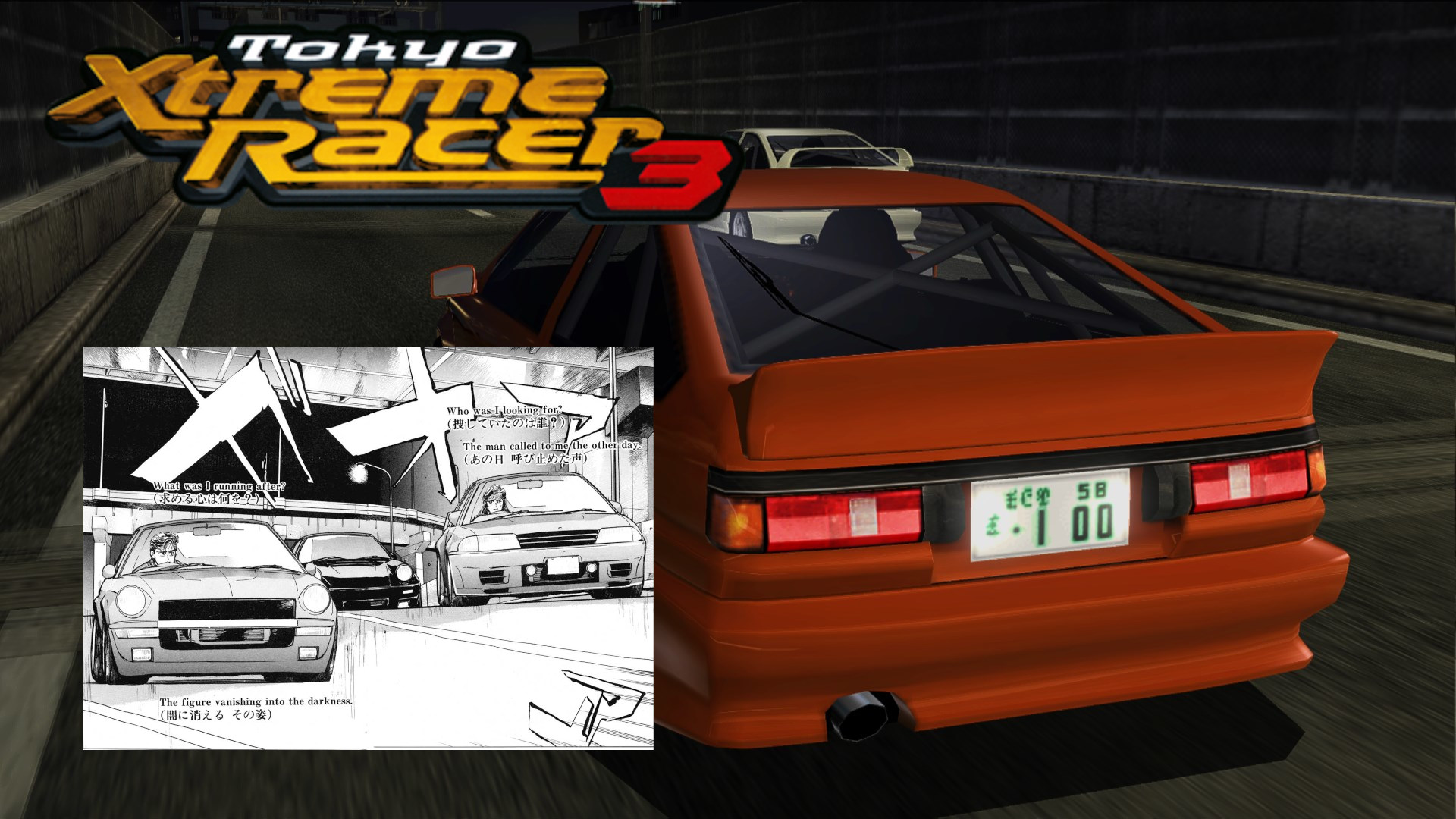Tokyo Xtreme Racer 3
The final game for "Anime NYC" week is a title that, at first glance, clearly isn't an "anime" game. Before you cast this off as me getting an excuse to talk about a game I missed out on during my childhood (despite you being right...) hear me out first. Often imitated and duplicated, the Tokyo Xtreme Racer series made its debut on the Sega Dreamcast, known as Shutokou Battle. The unique highway racer was successful enough to warrant a direct sequel on the same console. A soft "reboot" was released on the PlayStation 2 as Tokyo Xtreme Racer Zero, followed by the direct sequel Shutokou Battle 01. Thanks to questionable naming conversions in English, 01 was known as Tokyo Xtreme Racer 3 even though this was the fourth game.
I suppose maybe "01" would have been hard to properly pronounce, but in the main menu, there's a voice that says "ZERO ONE!" so I fail to see why this was named so. Regardless, TXR 3 has been a game that received buzz lately. What poised me to come back to this title after almost two decades was a video I've seen that compares this game to Need For Speed Underground. The comparison couldn't be any more wrong, but I understand why one would link it to Underground. The Shutokou Battle series was always rooted in Japanese car culture, a trait that would continue through its spinoffs.

There are hundreds of rivals to race against, each with its own stories that can be read in the rival list menu. What drew me into the 'lore' of the Shutokou Battle series as a whole is the biographies of the drivers. These aren't just generic AI drivers you're going against, these are actual characters that speak through their driving style. Most are average everyday people including band members, salarymen, models, actresses, and students. While the general plot for each game in the series is to be the best driver on the Tokyo highways, some drivers and teams reappear in each game with a follow-up on their lives from the previous games.
With that said, the overarching story was never its strong suit. You show up as an unknown, a cool cutscene plays with very questionable translation decisions, and you're told to pick a city. Tokyo Xtreme Racer 3 is the only game in the series that adds two new cities outside of Tokyo which is Nagoya and Osaka. As tempting as it is to go to the new cities, I recommend starting in Tokyo for pacing reasons. The initial maps in Nagoya and Osaka are simply too small to enjoy the early game (Osaka is literally a rectangle at first).

As with the previous titles in the series, once you purchase your starting car, you start your street racing career on the highways. On the map, there are blue arrows moving about, signaling a new rival you have yet to challenge. To challenge a rival, simply drive behind them and flash your high beams. After that, a cutscene will play and you'd have engaged in a battle, on the shutokou, hence the name Shutokou Battle!
There is no "point A to point B" sprint races or a "finish line" to speak of, as the only way to win a race is by depleting your opponent's health bar to zero. A player's first experience with this game will likely compare it to a fighting game and they wouldn't be entirely wrong. The most reliable way of ensuring victory is simply driving faster than your opponent. The greater the distance the faster the health bar depletes. If the trailing racer collides with the wall or other vehicles, it will also deal damage in relation to how direct the hit was. Upon winning the race you earn credits and begin to build up a multiplier based on win streaks.

In the early game, the health bar system ensures that even a weaker car can win against a powerful one. This is the second reason why I recommend starting in Tokyo as the C1 Loop has many twists and turns to trap your opponent in. The AI simply cannot handle corners well and the infamous toll road is where they tend to fumble hard. Just look at its inclusion in Gran Turismo 7. Tokyo is split into two sections of the highway initially, the C1 Loop and the New Belt Line. The former's technical design is suited for fighting and nimble vehicles. Players who are confident about their car's top speed can opt to completely evaporate their opponent in the New Belt Line instead.
Defeating enough rivals from a specific team will flush out the Team Leader who usually drives a far greater car than anyone on the team prior. At this point in the game, it's entirely okay to win with "dirty tactics" than flat-out speed. In the later stages, you'll need to use both your wits and your power, but for now, ramming a car into a divider is valid. Car damage exists in this game, but not in the way that one would expect from traditional racers. It all involves monitoring your car's oil and engine temperature.

To prevent the player from simply challenging every driver on the highway, there's a "soft timer" in the form of oil temp and engine temp. The harder you push your car, the quicker the temperature rises. Not all cars rise at the same rate, some have better-advanced cooling than others.
If driving a Turbo car, the player can use a turbo boost indicated by a glowing red light that gives their car enough speed to take on almost everyone. This comes at the cost of the temperature increasing rapidly to the point of "engine deterioration" as the game states. The number will be in red and you can even see smoke coming out of the exhaust.

Placed along the expressways are Pit Stops where the player can adjust their car settings, change the route they're driving on, and most importantly, reset their temperatures to normal. This becomes a risk-reward situation as deciding whether it's best to race everyone or rest up can mean the difference between proper pacing and having a team leader ambush you while weakened.
Defeating enough rivals and team leaders will garner the attention of the Bosses. These are special races that are needed to progress through Quest mode. A Boss doesn't necessarily mean they drive a "fast car," but rather their personalities are accentuated through their driving.

The first Tokyo boss, Betrayal Jack Knife, will literally ram your bumper until you mess up and let him pass. His defense is his downfall so it's easy to regain the lead and keep up his tactics. Upon defeating the bosses, as well as the final boss of a stage, you move on to the next city. Rinse and repeat until the second half of the game where each city has a new expansion added to the map. In Tokyo's case, it is the Wangan, that you happen to drive around Midnight.
Before the release of Tokyo Xtreme Racer 3, Namco and Genki worked on an arcade racing game based on the Japanese manga Wangan Midnight. The series focused on Akio, a young racer with a deep-blue Nissan S30Z that's blisteringly fast to the point he gets the nickname the "Devil Z." Before Genki developed Wangan Midnight, they included the car in Shutokou Battle historically as the final challenge the player battles once they defeat all rivals. They aren't known by their name, but simply "???" although all signs obviously point towards Akio and the Devil Z.
Wangan Midnight is to highway racing as Initial D is to mountain racing, with both the Toyota Corolla AE86 and the Nissan S30Z being iconic models in car culture. The original Wangan Midnight took elements from the Tokyo Xtreme Racer titles, including the life bar, and the game would be ported to the PlayStation 2. Namco themselves took the ball and ran with it to the endzone, developing the Maximum Tune series. I supposed once they remembered they too developed racing games, Namco floored it (pun intended sorry). Genki would develop and release another Wangan Midnight title in 2007 but more along the spirit of the arcade games.
It's safe to say that there probably wouldn't be an emphasis on highway racing in Shutokou Battle if it wasn't for the popularity of Wangan Midnight. These days, racing fans know of the game through Maximum Tune, a series still going on to this day. In turn, Genki is responsible for the popularity of the Maxi Tune arcade games as well. There are also references to anime within the biographies of the rivals, furthering its in-depth roots in anime and car culture.

While I would traditionally end this retrospection with a "You must play this game now!" I'll preface it with "Only play it if you have access to cheats." That's because it is literally impossible to complete the game in the US version because of a rather silly translation error. Let me introduce you to Whirlwind Fanfare, an otherwise unremarkable Wanderer with an even less remarkable Suzuki Wagon. Wanderers are solo drivers, such as the player themselves, who sometimes require interesting requirements to show up much less race.
Some race on a certain day of the week, others race during specific weather, if you're driving a certain car, and even if you have a certain license plate. In order to race Whirlwind Fanfare, you'll need 100,000,000 Credits which isn't the most difficult thing to obtain in the late game. The problem is that during the translation process, Credits were converted from Japanese yen to United States dollars. This conversion meant that the highest a player can obtain is 99,999,990 Credits. Ten credits short of the requirement.

Imagine being so close to completing the game, because remember you need to defeat every single rival to take on the final boss, only to be stumped at the last possible rival because of ten credits. The only way to remedy this situation is to cheat to get more money than you possibly can. You have to cheat in order to win a game that's otherwise literally unwinnable. Thanks to modern technology, various save data, and emulation this can be achieved with no problem. Back then, the younger me was furious and I didn't even attempt to beat the game because why bother?
With that said, if you can find a way to play the game in a way that you can cheat to obtain this final driver, then by all means don't hesitate to give Tokyo Xtreme Racer 3 a spin. It would be the final game in the series to include the Wangan and Bayshore route as the next and final Shutokou Battle game, Import Tuner Challenge, would strip away most of its features. Regardless, of whether you want to call it Japanese Underground or not, this series was an important series inspired by an often overlooked manga series.

